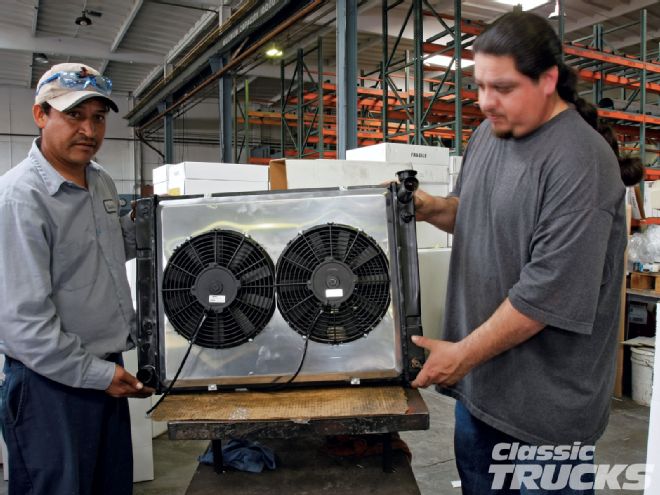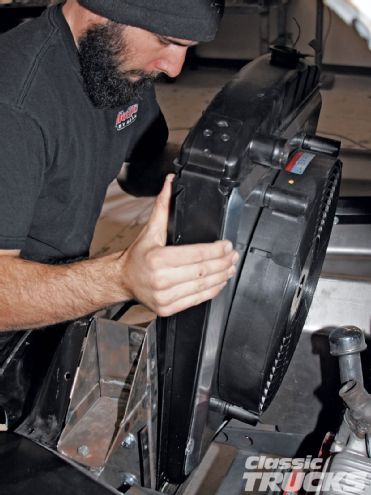
During the course of building a classic pickup a lot of time and imagination is spent on the project's overall look. Color, stance, wheel choice, interior design, and maybe some exotic bed wood lead the way. After all, appearance is the goal when building something that's pretty much an extension of its owner's personality. That's all good, but practicality is even more important in many ways. What good is a beautiful classic truck if it's not a reliable driver? One mechanical facet of a classic pickup project's success is one that doesn't often end up near the top of the must-have list, and that's a good reliable cooling system. Choosing a radiator and fan may not be as much fun as choosing an engine, paint, or wheels, but waiting until everything else is done and then trying to find a radiator and fan that'll fit is not the way to keep a classic truck cool.

Think back to all the hot rods and/or trucks you've seen on the side of the road or pulling out of line at the entrance to a car show, sweet-smelling steam blasting from the radiator and a telltale green trail running down the pavement. Don't let that be your ride. We certainly don't want that to be Project Shop Truck when it does eventually hit the road.
As you know from recent articles, Project Shop Truck is our sister publication STREET RODDER magazine's stab at building a custom '47 Chevy truck completely from aftermarket parts. They're counting on it to be a reliable cruiser and getting the cooling system right is a critical part of achieving that. Besides that, the truck's going to have the SR name painted all over it and it wouldn't be good PR to have their rolling billboard parked in a puddle of its own chartreuse juice.
The first key to running cool is to move water. That means selecting a radiator that will drop the coolant temperature sufficiently. Their choice was one of U.S. Radiator's new Triple Flow radiators. The Triple Flow has walls inside the core that route water through the radiator three times instead of just once. Don Armstrong at U.S. Radiator explained that this technology isn't new, but has been used for years in Midget and Sprint Car racing.
Did you notice that the inlet on this radiator (PN 80071) is located on the left side? This is so coolant can be fed down the left side, then back up the center, and down the right side before hitting the outlet, effectively tripling the surface area. According to U.S. Radiator's testing, it also reduces outlet water temperature an average of 15 percent over single-pass radiators.
The second key to running cool is moving air. Without air moving through the radiator, the outgoing water isn't going to be much cooler than the water going in, no matter how much surface area you give it.
At highway speeds, the motion of the truck forces air through the radiator, but when stuck in traffic or idling in line at that truck show, you need a reliable fan to keep cool. For Project Shop Truck, they could have chosen a mechanical fan, driven by the engine, but decided on an electric fan. One reason is dependability under slow-speed conditions, when engine rpm is low and air isn't being forced through the radiator by the motion of the car.
Another reason is that a compact electric fan would fit in the limited space of the '47 Chevy's engine compartment. That was their theory anyway, but we'll get to that in a bit.
To go along with their Triple Flow radiator the guys ordered a 17-inch High Output Single RAD Fan Kit (PN 16217) from Derale Performance. Derale has tested this fan to move up to 2,400 cubic feet per minute. In testing U.S. Radiator got a reading of 320 linear feet per minute using a handheld airflow meter. In either case, it's plenty of air movement for Project Shop Truck.
This Derale fan features a symmetrical housing so that it can be mounted on either side of the radiator for use as a pusher fan or puller fan. They mounted it on the rear of the radiator as a puller, which is more efficient. Pusher fans have the disadvantage of physically obstructing airflow to the radiator, and pushed air is more likely to bounce against the radiator causing turbulence.
Getting the most advantage of a puller fan requires a shroud between the fan and the radiator. Since the whole purpose of the fan is to draw as much air as possible through as much of the core as possible, they chose the largest diameter that would fit. But without a shroud, even a 17-inch diameter round fan would miss a lot of potential air from the four corners of the 203/4x193/4-inch radiator, so they had U.S. Radiator create an aluminum shroud before shipping the fan and radiator to Hot Rods by Dean in Phoenix, where they were waiting to install it in the Chevy.